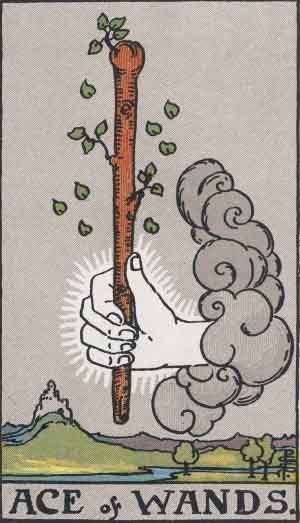 | ||
Atziluth or Atzilut (also Olam Atzilut, עולם אצילות, literally "the World of Emanation"), is the highest of four worlds in which exists the Kabbalistic Tree of Life. Beri'ah follows it. It is known as the World of Emanations, or the World of Causes. In the Kabbalah, each of the Sephiroth in this world is associated with a Name of God, and it is associated with the Suit of Wands in the Tarot.
Contents
Significance
Atziluth is the realm of pure divinity. The four worlds of Kabbalah relate to the Tree of Life in two primary ways:
It should be remembered that in Kabbalah each of the ten Sephirot of the Tree of Life also contains a whole tree inside itself. In this philosophy of the "whole in the part," Kabbalastic theories are in harmony with David Bohm's model of implicate order. The realm of Atziluth is thus related to the top three Sephirot of the Tree of Life; these three spheres of Kether, Chokmah and Binah are considered to be wholly spiritual in nature and are separated from the rest of the tree by a region of reality called the Abyss.
Origins
The word is derived from "atzal" in reference to Numbers 11:17; and in this sense it was taken over into the Kabbalah from Solomon ibn Gabirol's Meḳor Ḥayyim (The Fountain of Life), which was much used by Kabbalists. The theory of emanation, which is conceived as a free act of the will of God, endeavors to surmount the difficulties that attach to the idea of creation in its relation to God. These difficulties are threefold:
- the act of creation involves a change in the unchangeable being of God;
- it is incomprehensible how the absolutely infinite and perfect being could have produced such imperfect and finite beings;
- a creatio ex nihilo is difficult to imagine.
The simile used for the emanation is either the soaked sponge that emits spontaneously the water it has absorbed, or the gushing spring that overflows, or the sunlight that sends forth its rays—parts of its own essence—everywhere, without losing any portion, however infinitesimal, of its being. Since it was the last-named simile that chiefly occupied and influenced the Kabbalistic writers, Atziluth must properly be taken to mean "eradiation" (compare Zohar, Exodus Yitro, 86b).
Later on the expression "Atziluth" assumed a more specific meaning, influenced no doubt by the little work, Maseket Atzilut. Herein for the first time (following Isaiah 43:7: "I have created"; "I have formed"; "I have made"), the four worlds are distinguished: Atziluth, Beri'ah, Yetzirah, and Assiah. But here too they are transferred to the region of spirits and angels:
In the Zohar, Atziluth is taken to be simply the direct emanation of God, in contradistinction to the other emanations derived from the Sephirot. No fourfold world is mentioned.
Moses Cordovero and Isaac Luria (sixteenth century) were the first to introduce the fourfold world as an essential principle into Kabbalistic speculation. According to this doctrine,
In contradistinction to the Atzilah-world, which constitutes the domain of the Sephirot, the three other worlds are called by the general name "Pirud". Later Kabbalists explain "Atziluth" (according to Exodus 24:11, and Isaiah 41:9) as meaning "excellence," so that according to them the Atzilah-world would mean the most excellent or highest world.
